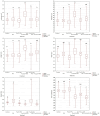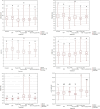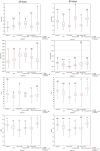Enhancing Germination and Growth of Chrysanthemum Synthetic Seeds Through Iron Oxide Nanoparticles and Indole-3-Acetic Acid: Impact of Treatment Duration on Metabolic Activity and Genetic Stability
- PMID: 40125333
- PMCID: PMC11929542
- DOI: 10.2147/NSA.S503868
Enhancing Germination and Growth of Chrysanthemum Synthetic Seeds Through Iron Oxide Nanoparticles and Indole-3-Acetic Acid: Impact of Treatment Duration on Metabolic Activity and Genetic Stability
Abstract
Background: This study investigated the effects of pure iron oxide nanoparticles (Fe3O4 NPs), citrate-stabilized iron oxide nanoparticles (Fe3O4CA NPs), and indole-3-acetic acid (IAA), applied at various time regimes, on the germination, growth, and ex vitro development of chrysanthemum synthetic seeds. The genetic and metabolic stability of the plants was also assessed.
Methods: Nodal segments of Chrysanthemum × morifolium /Ramat./ Hemsl. 'Richmond', with a single axillary bud, were encapsulated in 3% calcium alginate with the addition of IAA (1 mg·L-1) and/or NPs (7.7 mg·L-1). The synthetic seeds were cultured in vitro for 30 or 60 days on a water-agar medium and then transplanted to the greenhouse for further analyses.
Results: Results indicated that IAA and Fe3O4CA NPs applied singularly significantly enhanced germination rates (83.33-92.18%) compared with the IAA- and NP-free control (56.67-64.18%), regardless of treatment time. The simultaneous use of IAA and Fe3O4CA NPs promoted longer shoot development after 30 days of treatment but showed negative effects after extended exposure. The same combination improved rooting efficiency compared to IAA alone. Supplementation with NPs improved acclimatization rates for younger plants but had variable effects on older plants. Leaf growth metrics were enhanced with Fe3O4CA NPs in plants after 30 days of treatment, yet no significant differences were observed in leaf dimensions after 60 days. The content of flavonoids, anthocyanins, and chlorophyll was affected by the exposure duration. Biochemical analyses revealed increased total polyphenol content and antioxidant capacity (FRAP, ABTS) in treated plants, particularly with IAA and Fe3O4CA NPs. Start codon targeted (SCoT) analyses showed no polymorphisms among treated plants, confirming their genetic stability.
Conclusion: The study found that the combination of IAA and Fe3O4CA NPs improved germination and shoot development in chrysanthemum synthetic seeds, while maintaining genetic stability, although prolonged exposure negatively affected plant growth metrics.
Keywords: Chrysanthemum × morifolium /Ramat./ Hemsl.; SCoT; antioxidant capacity; molecular markers; nanotechnology; polyphenols.
© 2025 Kulus et al.
Conflict of interest statement
The authors have no relevant financial or non-financial interests to disclose.
Figures





References
-
- Miler N, Jedrzejczyk I. Chrysanthemum plants regenerated from ovaries: a study on genetic and phenotypic variation. Turk J Bot. 2018;42(3):article5. doi:10.3906/bot-1707-19 - DOI
-
- Globenewswire. 2023. Available from: https://www.globenewswire.com/en/news-release/2023/03/01/2618503/28124/e.... Accessed September 27, 2024.
-
- Miler N, Wozny A. Effect of pollen genotype, temperature and period of storage on in vitro germinability and in vivo seed set in chrysanthemum — preliminary study. Agronomy. 2021;11:2395. doi:10.3390/agronomy11122395 - DOI
-
- Reddy M, Sri K, Murthy R, et al. Synthetic seeds: a review in agriculture and forestry. Afr J Biotechnol. 2012;11:14254–14275. doi:10.5897/AJB12.770 - DOI
-
- Abbas MK, Mahood HE, Alhasan AS. Production of synthetic seeds in vegetable crops: a review. IOP Conf Ser. 2022;1060:012099. doi:10.1088/1755-1315/1060/1/012099 - DOI
LinkOut - more resources
Full Text Sources
Miscellaneous

